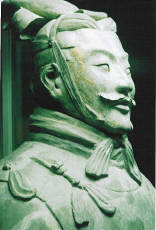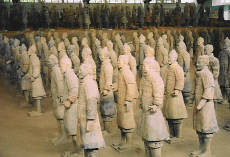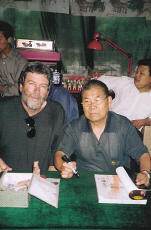Emperor Qin’s Army
Xian, China


Army and uncovered mounds.
![]()
![]()
The army stands in place, nearly 7000 strong. Arrayed in battle formation, unmoving; not even blinking; they are a juggernaut about to pounce. Each face is unique; a study in concentration of warriors ready to die.
The commanding general and his aides ride chariots behind armor shrouded horses. Legions of archers, lancers and foot soldiers surround them. A sense of doom pervades the air. War is about to be unleashed.
Most amazingly, this army lived 2500 years ago.
We have braved the summer monsoons of central China, traveling to Xian in a pelting downpour. I welcome the cooling rain after the sweltering humidity of Beijing, knowing three dozen people have died in the floods. This is the normal state of affairs for China in summer. We spend most of an afternoon sitting next to an underwater highway, watching military engineers attempt to pump away an inland sea of rainwater. They wave me off when I attempt to take photos. Discretion must be used when taking pictures in China. The military must look its best, and they do not like being seen doing manual labor. Our driver passes the day chain-smoking Marlboros and cursing the weather. I tell him we will wait all day if necessary. He smiles at this through a cloud of smoke. We are here to see the Terra Cotta Army of Emperor Qin.
In 259 BC, China was a series of feuding states commanded by local warlords all calling themselves “King.” That year, the wife of the “King” of Qin province bore a son, Zhao Zheng. When the boy was 13 his father died and he ascended the local throne, changing his name to Ying Zheng. Being too young to govern, his mother administered the affairs of state till the boy reached the age of 22. At that time he began a series of military conquests to unite the various provinces. In 221 BC, at the age of 39, he had defeated the six ruling warlords and united the country, declaring himself to be “Qin Shi Huang Di,” First Emperor of Qin.
Today he is known as Emperor Qin, and the modern state of China claims its name from him.
Emperor Qin suffered a lifelong fear of death. He constantly searched for an elixir to guarantee his immortality. Having failed to find one, he decided to assure himself an easy passage into the hereafter by taking his legions with him. He amassed an army of artisans almost as large as his military. He commanded them to create a life-size clay duplicate of every soldier in his service. One by one his soldiers modeled for the sculptors. As each statue was finished, it was fired in a kiln, painted, and mounted in a giant pit, exactly where that man would stand in formation on a battlefield. When they finished, the emperor had a terra cotta duplicate of his entire army.


Commanding general.
![]()
![]()
Qin died, at the age of 50. The next Emperor ordered all of Qin’s concubines who had not born him children put to death and interred with him. The thousands of artisans who created this wonder were also put under the sword, to assure it remained a secret to the outer world.
For 2,400 years, the army stood silent and unknown, covered in its tomb next to the Emperor himself.
In 1974 a poor farmer named Yang Jun Peng dug a water well for his village. Breaking into a dark cavern, he found small pieces of metal and shards of terra cotta. At first he was disgusted at not finding water and tossed the pieces away. A village elder realized the importance of his find and notified local authorities. Four months later a massive excavation began. No one was prepared for what they would find.
Two thousand years of earthquakes, floods, and a fire had taken its toll. Most of the army was in small pieces. Still, the sheer size of the discovery dictated a massive effort on the government’s part. Museum curators and restorers were dispatched to begin assembling the world’s largest jigsaw puzzle.
By 1979, more than 1,000 warriors had been reassembled, plus 300 horses and dozens of chariots. A massive museum complex was constructed to house the army and its restoration. In 1987, UNESCO declared the area a World Heritage Site.
The army finally lowers the water enough for us to creep through, and we slip and slide into the parking lot. I see two buses unloading their cargo of saffron-robed monks. As each one disembarks, they immediately open identical white umbrellas. Arm in arm they scurry into the building like a moving garden of mushrooms. I follow them inside, snapping their photos and amusing them greatly.
The first look at the army is overwhelming. They occupy an enormous pit inside a building the size of an airline hangar. It is dark inside, for daylight can damage these delicate pieces.


Terra Cotta Infantrymen.
![]()
![]()
Most of the warriors are over six feet tall; some are close to seven. These soldiers were recruited from northern Mongolian stock and were formidable in size. The statues tower over modern-day Chinese. The detail is astonishing.
Each piece of armor is articulated. Mustaches, beards, hairstyles, even fingernails are rendered with exacting craftsmanship. Archers wear silk scarves to swivel their necks without rubbing them raw on leather gauntlets. Boot soles have ripples. Thongs wrap around leggings so they will not catch the brush while on the march. Hair is tied to one side, allowing a clear draw of an arrow from back quivers. Horsemen have spurs and infantrymen wear body armor. Horses wear leather jerkins to ward off arrows and blinders to keep them moving forward. If a piece of equipment existed in the actual army, it was faithfully recreated.
Row after row stand in silent formation, waiting for orders. It is more than daunting to stare into faces that lived and fought more than two millennia ago. Every statue is unique. Each is the death mask of its owner. No one speaks here. Partly out of reverence, but even more, it is the unconscious longing to hear the order for battle to be called. At any moment the march will begin. This army is alive.
In 2002 the army numbered 7,000, along with several hundred horses. Ground-piercing radar has detected shards still underground that when finally excavated will produce an army in excess of 100,000 soldiers.
Sadly the Chinese government has neither the funds nor experienced personnel to finish this task in our lifetime. At the time of my visit, excavation and restoration was crawling along at two days a week with a tiny handful of people on the job, mostly student volunteers working under the tutelage of local university personnel.
My wife and I spend most of a day with the army. Flash photography is not allowed, so I use a tiny tripod. Braced against the railing, I take timed exposures.
Soldiers stare at me through the viewfinder, and I think of the history that passed while this army has stood in place. They were assembled before Christ walked the earth, and long after I am gone, they will guard their Emperor. We leave with regrets, for it is not easy to break from its spell.


James Dorsey, the author, and Yang Jun Peng, the discoverer.
![]()
![]()
Near the exit I notice a small man sitting at a table. He is drinking a Coke and smiling at all that pass him. At first I take him for an official greeter, an honored job in such places. Then his image pops into my mind.
I have seen this man in books. It is Mr. Yang Jun Peng, the discoverer of the site that has become China’s single largest tourist attraction. More people come to see this army now than visit the Great Wall. Most people walk right by without realizing he has been declared a living national treasure. His job is to sign books and pose for photos, but today, none of his countrymen recognize him.
He is visibly pleased when I approach. We share no common language, but I smile and bow. He puts his arm around me and my wife snaps our photo together. I have given him great face, and a crowd begins to gather. He smiles broadly at the recognition and begins to sign books for his admirers. I slip out the door behind him, and he gives me a final bow.
There is a brilliant sunset outside, and for a moment, I think I hear the commander calling his troops to arms.